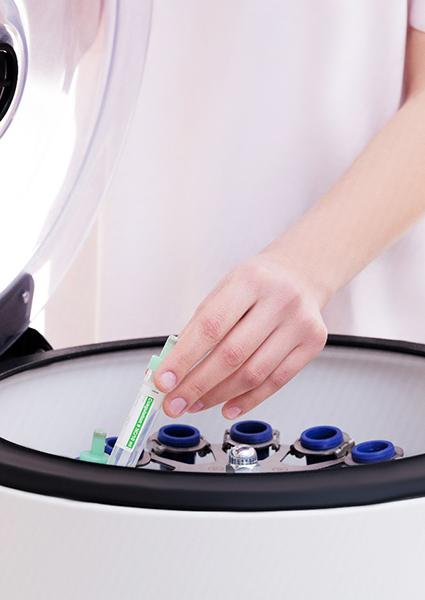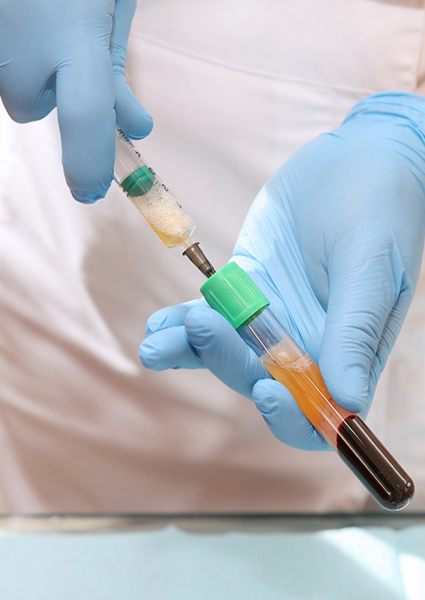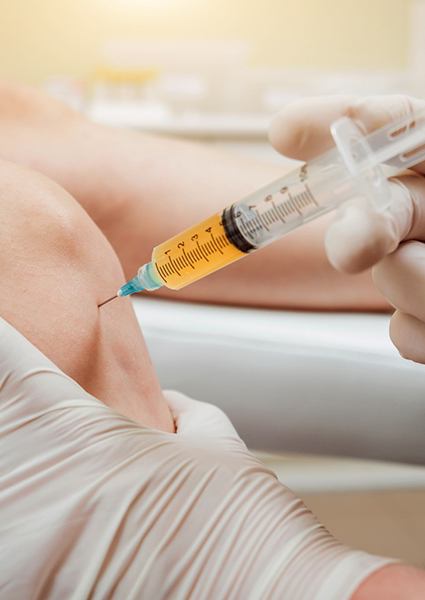Platelet-Rich Plasma (PRP) Therapy—Hollywood, FL
Make Your Pain Finally Go Away
In the realm of regenerative medicine, PRP therapy is by far one of the most popular treatments. Why? Not only can it help patients quickly heal from a wide range of acute and chronic injuries, but it is also extremely safe and supported by an ever-growing mountain of research. Our team has already used PRP to help countless patients in Hollywood and beyond, and if you’re ready to experience pain-free days again, it could be exactly what you need. To learn more and get started with this treatment, contact us today to schedule a consultation.
WHY CHOOSE THE INSTITUTE FOR NON-SURGICAL ORTHOPEDICS FOR PRP THERAPY?
- Refinement Process Creates the Highest Quality PRP
- Compassionate Team with Decades of Experience
- Injections All Made Using Ultrasound Guidance
PRP: The Basics

You probably learned about platelets (which is what your body uses to clot your blood if you get a cut) in school, but what exactly is platelet-rich plasma?
It is actually regular blood that has been separated into different components. A small sample of a patient’s blood is collected, and then it’s spun in a centrifuge. The result is that the liquid plasma (mostly water) is removed, and what is left is a thicker substance that is rich in several growth factors that can regenerate tissues—PRP.
Using ultrasound guidance, the PRP can then be injected in or near injured tissues in order to stimulate the healing process.
How PRP Heals the Body

In broad terms, “growth factors” (which refer to a collection of several proteins and even some hormones) are the fuel your body uses to heal itself. With PRP therapy, a specific part of the body is given an extra, highly concentrated dose of this fuel, which allows the tissues to renew themselves much faster than normal.
The result? Inflammation finally decreases, pain goes away, and strength and mobility are restored. After a patient notices results, they tend to improve over the course of a few weeks, and they can be trusted to last for several months to a year before the patient may need a follow-up treatment.
Conditions that Can Be Treated by PRP

PRP is currently being researched around the clock across the globe, and all the data points to one thing: it works! It has been used to treat virtually every area of the body, and at the Institute for Non-Surgical Orthopedics in Hollywood, we have utilized PRP to successfully heal patients with:
- Neck pain
- Shoulder pain
- Back pain (upper, mid, and lower)
- Hip pain
- Knee pain
- Ankle pain
- Foot/heel pain
- Elbow pain
- Osteoarthritis (OA)
- Slow healing wounds due to diabetes or other conditions
Platelet Rich Plasma (PRP) Frequently Asked Questions

PRP has quickly become one of the most popular regenerative treatments in the world, but of course, people still have questions about it! Below, you’ll find our responses to some of the most common ones we receive. If you would like to ask about something we haven’t touched on here, be sure to contact our team.
How long does a PRP session take?
A patient’s very first visit will take a little longer because the doctor will give them a complete exam, but typically, a PRP session is about one to two hours from start to finish. This includes drawing the blood, spinning it in a centrifuge, harvesting and refining the PRP, and finally, injecting it into the patient with the help of ultrasound.
Does PRP contain exosomes?
No, PRP does NOT contain any live exosomes. Its ability to stimulate the healing process is due to the high concentration of platelets as well as many other growth factors and proteins the body uses to generate new tissue. The biological driver of this healing does not involve exosomes in any way.
Am I a good candidate for PRP?
When you come in for a visit, you’ll have a chance to describe your symptoms and health history, and then your doctor will perform a detailed exam. From there, they will discuss your goals and help you determine which type of treatment would be best for you. PRP is typically considered a “middle-ground” between more conservative therapies (like rest, heat, icing, bracing, etc.) and invasive ones (surgery).
Based on the severity of your injury and how quickly you would like to recover, your doctor will recommend PRP or another one of our treatments. Generally, PRP is more potent than prolotherapy or Prolozone, but not as strong as Whartons Jellytic growth factors (and this is reflected in the cost of each of these therapies).
When is PRP NOT Recommended?
While PRP has a long list of applications within regenerative medicine, it is not a miracle cure. For patients with complete tissue tears or almost no joint cartilage because of advanced osteoarthritis, PRP will offer minimal benefit. Usually in these situations, our team will recommend a more robust treatment, like Whartons Jellytic growth factors, or suggest surgery in some cases. While PRP might not be able to help with someone’s specific injury, our team can work with the patient to speed up their recovery process after receiving another treatment so they are able to get back to 100% as fast as possible.
Are PRP Injections Painful? Are They Safe?
Here at the Institute for Non-Surgical Orthopedics of Hollywood, we want our patients to be as comfortable as possible. We use a local anesthetic during PRP sessions so your feel minimal discomfort. After your injections, mild soreness, and in some cases, bruising, are normal.
You can be confident in the safety of PRP. Since the treatment is derived from your own blood, there is virtually no risk that your body will have a bad reaction to it. Infections are almost unheard of with this type of treatment.
How Many Times Will I Have to Undergo PRP Injections?
It is common for patients to experience significant pain relief during the weeks after their first PRP session. Often, a single appointment is enough to kick start the body’s healing process and allow patients to feel and function their best.
Of course, there are some exceptions. If you have been suffering from a chronic problem, we might recommend that you visit us up to three times during a six-month period in order to receive PRP injections. We usually space appointments 4 – 6 weeks apart.
How Long Will the Results of My PRP Injections Last?
How long your results last will depend on a few factors. If you are dealing with a chronic condition, you may need to come in occasionally (perhaps once a year) for further injections. However, if your injury was acute, the PRP will aid in healing. You injury will not “un-heal” after the PRP is no longer actively at work in your tissues.
During your consultation, we will be able to provide you with information about how PRP may work for you in the long-term.
Will My Medical Insurance Cover PRP Injections?
Unfortunately, medical insurance companies tend to be a bit slow when it comes to offering coverage for advanced medical treatments, even ones that have been consistently shown to be successful, such as PRP. Therefore, it is unlikely that your policy will cover it. Nevertheless, it is worth checking with your insurance company to find out details of what they will and will not cover. Our knowledgeable team can help you navigate this process.
Without insurance, PRP may cost anywhere from several hundred dollars to a couple of thousand dollars per injection. Our team will be happy to explain your payment options.
Should PRP Be Combined with Other Treatments?
Often, PRP is used in conjunction with other treatments with the goal of helping patients experience optimum, long-term pain relief. When you visit us, we may recommend additional measures to encourage your body to heal. For example, we sometimes suggest that physical therapy be used to strengthen muscles and joints, as well as reduce the risk of future injury.
Also, keep in mind that we might urge you to avoid certain pain relief measures for a while. For example, limiting or eliminating your use of NSAIDs (such as ibuprofen and similar medications) after your PRP injections may help your treatment to work to its full potential.









